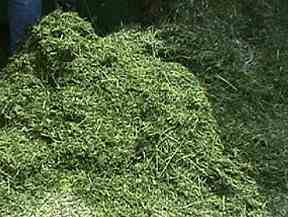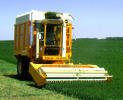Previous Page | Right click this page to print.
High Moisture Forages - Greenchop
In the U.S., greenchop is integrated into the seasonal feeding program of many dairy and beef operations. Greenchopping is also known as soiling or zero grazing.
Figure 9.9 illustrates greenchop.

To produce greenchop, forage is cut and chopped in the field and then
transported and fed fresh to the animals. Greenchop is primarily fed to
animals in confinement conditions. Generally, fresh greenchop is harvested
and fed once or twice per day.
Figure 9.10 illustrates a field chopper.

The chopper can be used to harvest forage for greenchop or silage. As
greenchop is the feeding of fresh forage, greenchop is available during
the growing season of the forage. Forages used for greenchop include forages
such as grasses, legumes, and grain forages. As with all forages, stage
of maturity at harvest is critical to the nutritional value of the forage.
In comparison to feeding of forages as pasture, hay, or silage, greenchop
provides the greatest opportunity to maximize digestible nutrient yield
per unit of land. Greenchop minimizes the dry matter, moisture, color,
and nutrient losses. Greenchop also minimizes the influence of the weather
during harvest. One significant disadvantage of greenchopping is the daily
requirement for labor and equipment to harvest and deliver the feed to
the animals. In general, to optimize production, greenchop is supplemented
with additional forages, concentrates, minerals, and vitamins.
Previous Page | Right click this page to print.